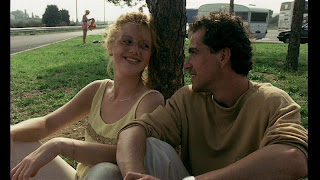One fine day I noticed that I have around 20-odd films lying with me that I haven't yet watched. So, I rummaged through them and randomly started selecting. Hence, over the past three days, I have watched Turistas (USA ), followed by Wolf Creek (Australia
Films watched in such a random order almost always entails serendipity. For example, I remember watching Vertigo and Basic Instinct back to back, and I can vouch for it that the change of color of dresses worn by Kim Novak’s character in the former has an eerie similarity to that of Sharon Stone’s character in the latter! Now, can that be true?
This time, the common thread between the aforementioned films was ‘disappearance’. While Turistas deals with disappearance of tourists in Brazil ; Wolf Creek
With the new millennium, a variant has emerged, which in common parlance is known as ‘torture porn’, made famous by films such as Hostel. While I was watching Turistas and Wolf Creek, I could not but wonder how we are no longer satisfied with the boogeyman being an ‘individual’. It is now an entire nation—sometimes Brazil , sometimes Bratislava , sometimes Australia
Anyway, I went a little off-track there. I started writing about this Dutch/French collaboration called Spoorloos (aka The Vanishing), so, let’s get back to it.
If you ask me to give a summary of the film, it really won’t read much—not enough to get you interested in what I consider one of the best mystery-thrillers ever made. Still, let me give it a try.
Rex Hofman and Saskia Wagter are a couple visiting France
Don’t get me wrong, it is not a mystery, per se, because we, the audience, are already privy to the fact who the kidnapper is. He is a family man, with a wife and two daughters. His name is Raymond Lemorne, and he teaches Chemistry. He meets Saskia for the first time inside the store and kidnaps her.
There is no connection between Raymond and Rex, except their initials. And you will notice how this fact is played into the film. When we first meet Rex and Saskia, they are playing a word game—names of animals that begin with the same letter. It is also a keychain with the initial ‘R’ that draws Saskia to follow Raymond to his car and get abducted.
Three years pass by. Rex, however, does not give up the search and his dogged determination to get to the root of it all is what ultimately lures Raymond to come and meet Rex with an offer that the latter laps up—letting Rex know what happened to Saskia.
What elevates Spoorloos to the level of a classic is the fact that underneath the exterior of a mystery-thriller, it is actually a film about knowledge and how far an individual will go to ‘know’. It is, at the same time, about the power of knowledge and the futility of it. In a one-of-its-kind ending, Rex gets to know the fate that befell Saskia, but he is helpless to do anything with what he has learnt.
There is a preponderance of yellow in the first half of the film—Saskia’s top, a frisbee, on a watch, a canopy, mention of yellow shirts… and the list goes on. To me, yellow symbolizes the act of waiting and wait is what the three main characters do in this film: Saskia for Rex, in a brilliantly conceived sequence inside a tunnel (the darkness inside the tunnel being a harbinger of what is to come) when their car breaks down; Rex for Saskia, when she vanishes into thin air and then to learn the truth about her disappearance; and last, but not least, Raymond waits for three long years before allowing Rex to know about Saskia’s fate.
What makes this film chilling is the ‘everyday’ feel to it. Raymond is no knife-wielding whacko. His ‘everyman’ bit is emphasized by how he meshes into a crowd when he baits Rex to come and meet him at a wayside place. How obviously commonplace he is that even when he is seated two chairs away from the man on whose life he wreaked havoc with one single act, the man fails to notice him.
Add to this the fact that such disappearance is also something we keep on encountering in all those ‘Missing persons’ columns. It is this ‘it could happen to any body’ aspect, the utter lack of motive behind the crime, and the fact that Raymond looks like any other guy we meet on the streets that add to the chill factor. All of these are summarized in the very first shot of the film where you see a stick insect, which can so easily be mistaken for a twig; or the grasshopper in the last scene, which effortlessly blends into the greenery, unnoticed.
Spoorloos is based on a novel The Golden Egg by Tim Krabbé, which reminded me of that fable I had read as a child, about the man who got a goose which lay a golden egg and how, he, in a fit of greed killed the goose to get all the golden eggs at one go.
That man is Rex Hofman. His ignorance was bliss, and when knowledge dawned on him, it was too late.




No comments:
Post a Comment